Tom's Guide Verdict
Apple's new iOS is more open and customizable than ever, catching up with Android in some ways while surpassing it in others.
Pros
- +
Extensibility lets apps interoperate powerfully and safely
- +
Continuity makes switching among multiple devices easy
- +
Family Sharing greatly simplifies managing multiple iTunes accounts
Cons
- -
Many of the most exciting features are not yet available
- -
Some features are glitchy
- -
Customization options don't extend to lock screen
Why you can trust Tom's Guide
iOS 8 isn't going to cause the same dropped jaws and befuddled looks from less tech-savvy acquaintances as did its immediate predecessor, iOS 7. That's because the striking thing about the latest update to Apple's mobile operating system isn't what's on the outside — though there's certainly no shortage of new front-facing features — but rather what lies beneath the surface.
While iOS 8 may not offer the same in-your-face design changes as iOS 7, the new operating system's tuned-up underpinnings are far more substantial than iOS 7's changes. Features like Extensibility and Continuity make it easier for both your devices and your apps to talk to one another, all of which goes toward making you more productive than ever. And parents will especially like the new Family Sharing features.
Device Support
iOS 8 supports devices as far back as the iPhone 4s, as well as every iPad since the iPad 2. The fifth-generation iPod touch can also be upgraded, meaning that pretty much the only device running iOS 7 that won't run iOS 8 is the iPhone 4, whose performance under last year's update wasn't much to write home about anyway.
That said, depending what model iOS device you're sporting, you may not have access to all of the new OS's features. The Health app is only available on iPhones and the iPod touch, while the Continuity functionality that lets you jump among tasks on multiple iOS devices, or between iOS and OS X, requires an iOS device with a Lightning connector.
The iPhone 4s, which is getting a little technologically long in the tooth, probably won't provide the best performance under the new OS either. So those users may want to think twice about upgrading, or consider that it may be time for a hardware upgrade.
But in comparison to Android, whose upgrade path is heavily fragmented to say the least, Apple continues to bring its software updates to the vast majority of its mobile users.

Interface
Get instant access to breaking news, the hottest reviews, great deals and helpful tips.
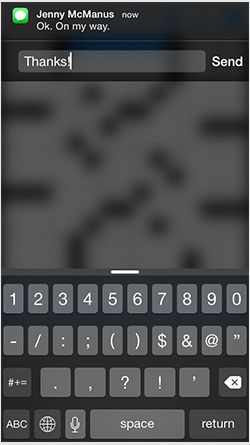
There aren't too many changes to the outward interface of iOS 8; some edges have been softened, some features slightly refined. Control Center now has better cues to distinguish when options like Airplane Mode, Wi-Fi, Bluetooth and so on are enabled or disabled; they're shown as filled-in circles, rather than simply outlined in white.
However, toggle the multitasking screen with the traditional double press of the Home button, and you'll see one new addition: a row of circular icons denoting your most recent contacts. It's an amalgamation of the people you've talked to in the Messages, Phone and FaceTime apps. Tapping on any of these icons provides you with a quick menu of ways to contact those individuals. Swiping to the right will also give you quick access to contacts you've marked as Favorites in the Phone app.
MORE: iOS 8 Adds Serious Security, Privacy Improvments
This people-centric approach may help those who don't want to dig down into the individual apps, but it will also require long-term iOS users to unlearn some muscle memory. (There's also an option to disable this feature in the Settings app, under Mail, Contacts, Calendars.)
iOS's Spotlight search feature, accessible by swiping down on the home screen, has also gotten souped up in iOS 8. Search now offers smart suggestions, based on your current location — if, for example, you search for a nearby restaurant — and on contextual cues. It can also return results from Wikipedia, current news, the iTunes Store, relevant websites and more, all as you type in your query. This helps speed the searching process and gets you to what you're looking for more quickly.
All of the above features are also available when you search from the location bar in Safari. Desktop Web browsers have sported these capabilities for a while, and they're a welcome addition on mobile, where generally the less typing you have to do, the better.

Finally, Apple also improved notifications in iOS 8, allowing users to act upon these alerts as they are received. As with the Recent Contacts feature, this may take some relearning: Swiping down on notification banners from the top of the screen used to bring up Notification Center; it now allows for contextual actions such as responding to a text message (including with the new voice message feature, more on that below), deleting or marking
emails as read, accepting or declining calendar invitations, and more. It's another great time-saver, especially for fervent multitaskers.
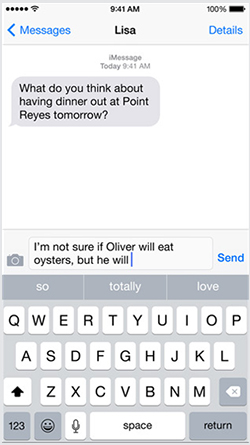
Keyboard
In iOS 8, Apple has for the first time added a substantial new feature to the built-in keyboard, adding predictive text features. This takes the form of a new QuickType bar at the top of the keyboard, which not only suggests words as you type them, but also attempts of determine from context what your next word will be. It even distinguishes between casual text conversations and, say, formal business emails.
In my tests, this feature worked pretty well, though the new keyboard didn't seem to save me as much time as I'd hoped. However, iOS 8 lets you generate some pretty funky haiku-style sentences just by choosing from the menu. If QuickType isn't quite your thing, you can always disable it in Settings, or replace the keyboard entirely with a third-party option (see Extensibility below).
MORE: iPhone 6 Review
Messages
Apple's taught the old texting dog some new tricks in iOS 8. At first blush, the Messages app may look largely unchanged, but it's picked up a couple of features that may please the Snapchat crowd, such as the ability to quickly send pictures, video and voice messages, all of which are, by default, automatically deleted after two minutes.
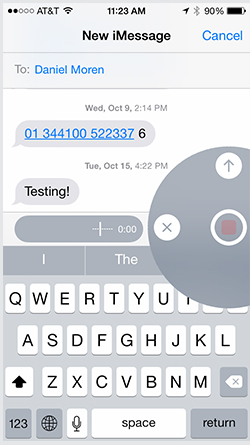
You can choose to keep these messages on a case-by-case basis, and the Settings app does let you set them not to expire by default. But it would be nice if there were more fine-grained choices for how long before they expire.
There's some clever user interface design at work in these new features. Tapping and holding on the microphone button will pop up a radial menu with options; you then slide your finger toward the control you want. When you've finished recording or taking a picture, Messages will instantly send the missive off to your recipient. (You can also swipe back to the x to discard your recording or picture.)
That one-finger operation should be particularly appealing to owners of the new, larger-screened iPhone 6 and 6 Plus devices, but the ability to simply raise your phone to your ear to listen, and respond, to voice messages is also extremely well implemented. Overall, the whole process of sending video and picture messages is greatly streamlined in iOS 8. Keep in mind, however, that these new messaging features rely on Apple's iMessage service, so contacts using Android, Windows Phone or other platforms won't be able to take part.
Apple says Messages is the most-used app on iOS, so it's no surprise that the company lavished attention on Messages here. Along with the new media-messaging features, there's a better photo picker and improved management of group conversations, including the ability to rename these interactions, exit them, share locations and mute notifications for specific threads.
Photos
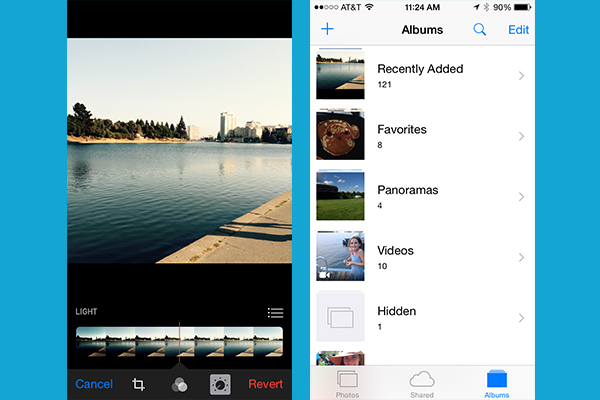
It seems like every tech company wants to help with your photos, and Apple's no exception (though it may have an uphill climb in users' eyes after the recent celebrity photo theft).
Among the improvements in Photos are new editing tools. While Photos has long allowed you to tweak aspects of your pictures, iOS 8 brings a new, simpler interface for those adjustments, in which you swipe across a filmstrip of spectrums, such as color and light. It's certainly easy to use and gives you a great idea of how your photo will look, but I expect most folks will stick with the even simpler one-button enhance feature that Apple has long offered.
Apple's trying to make it easier to organize and find your photos, too. Gone is the Camera Roll, now supplanted by a Recently Added album, alongside which you'll find collections of all your videos and panoramas, and a Recently Deleted album that holds onto pictures you've deleted, storing them for 30 days. (If you delete them from that album, they're gone for good.)
You can also finally hide photos by tapping and holding on a picture and selecting Hide, but it only conceals the images from the overview of your Photo Library, not from individual albums. In fact, hiding a photo creates a Hidden album where you can view all of those photos, so it may not be the best option for those looking to keep particularly sensitive pictures. You can also favorite pictures, by tapping the heart icon, which likewise creates a new Favorites album. While those new collections help you narrow things down, it would be nice if the app also let you create smart photo albums of your own.
There's now a search function in iOS 8, complete with suggestions for types of photos you might be looking for (such as those taken at your home, or near your current location). But the search criteria are largely limited to easily searchable information, such as location or date.
One promised feature that hasn't yet arrived is iCloud Photo Library, Apple's bid to keep all of your photos synced across all your devices. It's due to arrive in beta form in October, though a Mac client isn't scheduled to arrive until next year.

Family Sharing

Managing multiple iTunes accounts for a household has been a chore since day one. Family Sharing is Apple's latest attempt to address this can of worms, by letting families share purchased iTunes content across multiple devices and accounts.
Setting it up is easy enough: The organizer starts a family unit and invites other accounts. Once the family members have accepted, any content they buy will be charged to whatever payment method the organizer has linked to the account. Accounts for kids can be configured to request permission from the organizer before something is purchased, which helps parents keep an eye on kids' downloading habits. (This also potentially wards off rampant in-app purchases that have earned Apple and others the hairy eyeball from the government.)
Family Sharing is not without its caveats, though. If you leave the family, you'll lose access to the perks; any protected content belonging to others will no longer work on your device. You also can't be in more than one family unit or switch family units more than once a year. The latter seems like a somewhat arbitrary and onerous requirement, though content providers no doubt mandated it. And, unsurprisingly, not all content on the iTunes Store is available for sharing, depending on the whims of rights owners.
Extensibility

Along with being the most substantial improvement to iOS, Extensibility wins the award for the feature you'll probably have the most difficulty explaining to the average user.
Put simply, with Extensibility, iOS apps can now more easily communicate with each other. Extensions can take a variety of forms, from widgets that offer up information such as sports scores and headlines in Notification Center, to sharing services that allow you to quickly post to your favorite social media sites, to third-party keyboards such as longtime Android mainstay Swype.
It's a level of customization that Android has long had, and it's a welcome addition to iOS. In its typical fashion, Apple has restricted Extensions to certain places within the OS, and those sadly do not include the lock screen or home screen, which could definitely benefit from increased customization. But the capabilities of what Extensions can do are surprisingly wide ranging.
For example, the password manager 1Password can now fill in your login credentials in Safari on iOS, rather than requiring you to use the app's own built-in browser. That saves users time, and it brings the mobile platform one step closer to where the desktop has been for years. Social media sites that weren't previously supported by iOS, such as Pinterest or Instagram, can now offer easier sharing options.
It's going to be a little while before users see everything extensions can offer, but they promise to usher in a new era of customization for iOS. And Apple's solution aims to bring that flexibility without sacrificing the elegance and security that iOS users appreciate.
Extensibility doesn't address all customization issues users might want, however. While you can select the default search engine (to Google, Yahoo, Bing or DuckDuckGo), you still can't change the default apps for things such as mail, maps or Web browsing; it remains up to individual developers to integrate support for alternatives such as Mailbox, Google Maps, Chrome and so on.
Continuity
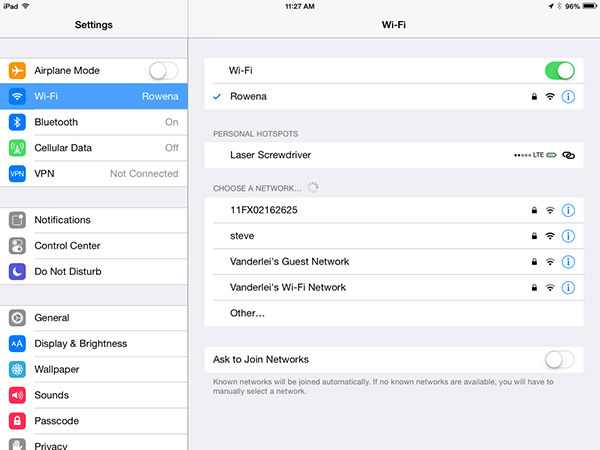
Many people have multiple iOS devices, and that's part of the reason Apple has introduced Continuity in iOS 8. This heading encompasses several different capabilities, including the ability to start one task — say, drafting an email on your iPhone — and then seamlessly continue it on your iPad. All rely only on users being logged into those multiple devices with the same iCloud account.
Of those Continuity features, I found that the Personal Hotspot detection worked like a charm, with my iPhone showing up in my iPad's Wi-Fi settings screen, even when the Personal Hotspot feature was off. The phone relay feature lets you answer conventional phone calls on your iPad, as long as it's on the same Wi-Fi network as your iPhone; it also worked pretty well, though on occasion it took a while for the call to ring on my iPad.
Perhaps the most interesting Continuity perk is Handoff, which lets you stay within the same document or webpage on multiple devices. I had a little trouble getting it set up: Even though it was enabled in Settings on both my devices upon upgrading, I had to switch it off and back on again before they'd recognize each other.
Once that was done, though, the feature worked flawlessly: I started an email draft on my iPhone and a small email icon would show up in the bottom left corner of my iPad's lock screen; swiping up on that popped me immediately into the draft, right back where I left off. The same worked seamlessly for Safari, Messages and Notes. Sadly, Handoff does not seem to currently work with iOS's media apps, such as Music, Videos, Podcasts or iBooks; you can't, for example start a song or movie and instantly pick it up on another device using Handoff.
MORE: iPhone 6 Teardown Reveals Detailed Specs
Performance (before/after)
A lot of people wonder whether iOS 8 and its plethora of new features will bog your iPhone down. We certainly wouldn't put the software on an old iPhone 4s, at least not yet. According to Ars Technica, iOS 8 is slower across the board versus iOS 7. But you should be fine with an iPhone 5s.
Here's a quick look at our benchmark results before and after we installed iOS 8 on an iPhone 5s. iOS 8 generally proved faster, with the exception of a slight increase in app load time.
| iOS 7 | iOS 8 | |
| Geekbench 3 (Overall Performance) | 2,556 | 2,542 |
| 3D Mark Ice Storm Unlimited (Graphics) | 13,795 | 14,259 |
| Sunspider (Javascript Browser)* | 774 ms | 430.9 ms |
| N.O.V.A 3 Game (Load Time)* | 4 seconds | 4.6 seconds |
*= Lower is better
iPad
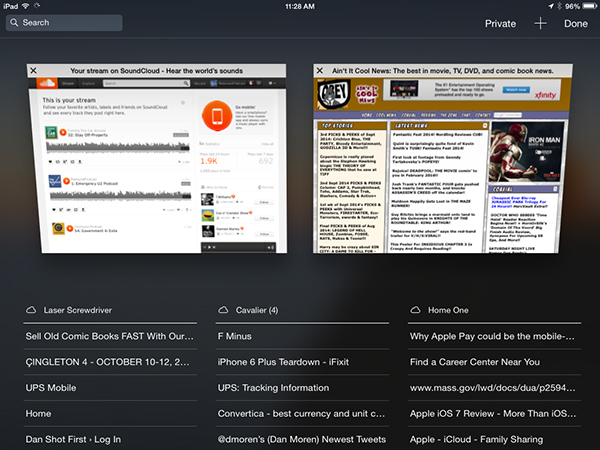
The iPad gets surprisingly few specific enhancements in iOS 8, and the only really prominent of those are in Safari. The browser has been redesigned and slimmed down; the tab bar and location bar now shrink down as you scroll, giving you more space for the Web content; and the Sidebar that contains your Reading List, Shared Links and Bookmarks now slides out from the left side of the page instead of popping over your content.
iCloud Tabs have been demoted to the new page overview, which is better laid out but not as easily accessible. And in that overview mode, tabs are now searchable (at least by their titles), which can help if you tend to have a preponderance of tabs open.
Features to Come
Extensions isn't the only aspect of iOS 8 that will require a wait-and-see approach: Several features aren't rolling out until October (presumably to coincide with the release of OS X Yosemite). These include the ability to answer SMS messages from your iPad and Mac, other Continuity features that work with the Mac, the aforementioned iCloud Photo Library, and the much anticipated Apple Pay system that works with the new iPhone 6 and 6 Plus.
And though Apple has launched its Health app in iOS 8, the company recently pulled from the App Store programs that take advantage of the HealthKit framework, due to a bug. So, for now, that app is relegated to information added manually and the Medical ID feature. The latter lets you create a profile that contains vital information such as allergies, blood type and more — essentially a digital version of the medical alert bracelet. It's accessible by tapping the Emergency button from the iPhone's PIN entry screen. Fortunately, it's up to the user what data is provided, which is good since such information is available from even a locked phone.
Finally, there's iCloud Drive, a cloud storage system that replaces Apple's current iCloud document syncing, but provides an actual file system, a la Dropbox. Note that iCloud Drive is not supported by the current version of OS X; if you rely on syncing documents or app data with your Mac via iCloud, do not activate iCloud Drive once you've updated to iOS 8. OS X Yosemite's release, coming later this fall, will add support for the new system. Users of Windows machines, or those who only use iOS devices, should be able to activate the feature without any concern.
Bottom Line
For most current users of iOS devices, iOS 8 is a no-brainer upgrade. As always, Apple's delivered an update that makes your current iPhone, iPad or iPod touch even more useful, and it won't cost you a dime. The addition of Extensions, and what that feature promises to unlock, is worth the nonexistent price of admission alone. Enumerating all of the individual improvements within iOS 8 would be beyond the scope of this review, but there's plenty to discover.
As for users of competing platforms, iOS 8 may not have any single advancement that will sway Android or Windows Phone devotees. In some ways, iOS is still catching up to what those systems offer, albeit at Apple's own pace and in the company's own particular style. But there are some unique perks of iOS 8 that Android doesn't offer, including Family Sharing and the clever Handoff between devices[8] [9] .
Even with the features that won't come to full fruition for another month or so, iOS 8 looks like it will live up to Apple's promise of the biggest update for the mobile platform yet.
- Apple Pay: Can You Trust It?
- iPhone 6 Review Roundup: What the Critics are Saying
- 6 Ways Galaxy Note 4 Beats iPhone 6
Follow Tom's Guide at @tomsguide, on Facebook and on Google+.
Dan Moren is the author of multiple sci-fi books including The Caledonian Gamibt and The Aleph Extraction. He's also a long-time Mac writer, having worked for Macworld and contributed to the Six Colors blog, where he writes about all things Apple. His work has also appeared in Popular Science, Fast Company, and more
-
williamclow When will Apple offer a mass delete feature for e-mails? Why must I delete them one by one?Reply -
IrritatediPhoneUser Ever since downloading iOS 8 my phone keeps freezing - especially when using facebook. Just another crappy update with great marketing from appleReply -
Shadis williamclow..not that you will probably read this, but you can mass delete emails. Once in the mail app click on edit in the top right corner, then select the emails you want to delete then click on trash or archive, depending on what mail type you are using(imap, pop or exchange).Reply -
Mikhailbeis Some improvements there, although most of them should have existed since iOS 0. Also, the feature that predicts your next word is really creepy.Reply -
turkey3_scratch Safari is the worst. New tabs are not even stored in the RAM as the page reloads between tabs. And it crashes constantly. More resource-intensive.Reply

